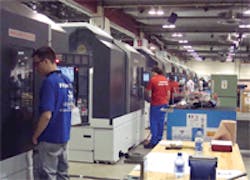The 40th World Skills 2009 competition in Calgary last month was eye-opening. I would not have imagined 900 competitors from 51 countries would devote seven days to demonstrating their proficiency at various skills. All in their teens or early 20s, these men and women represented themselves, principally, though their nationalities put their achievements into a “global” context.
Globalization has been with us for so long now that discussions of it are practically trite. The World Skills 2009 competitors reminded me that the world may seem more challenging, more demanding — but we remain responsible and accountable as individuals. We have to engage it as it is, and we must improve our skills, raise our standards, and elevate our efforts in order to succeed. Determination redeems us from ordinariness, but we need challenges to prove how good we are.
Dozens of competitors in the World Skills machining competition — including CAD design, CNC turning and milling, and a manufacturing team challenge that combined a series of such skills, including drafting and computerized design — proved that the standard is already high, but that ingenuity and confidence are in ample supply. (I should also congratulate the event’s planners and Mori Seiki, which provided over two dozen of its Dura Series vertical machines and lathes for the contest. Their dedication to individual achievement deserves our thanks.)
These competitors are the products of intensive educational and apprenticeship programs. The principles and techniques they’ve learned have been transformed into personal skills, which are valuable beyond price, confirming their talent and strengthening their confidence.
Talent is its own reward, but their determination to excel enriches all of us. By engaging the competition they are raising the world’s standards for excellence, and broadening our understanding of what manufacturing can achieve.
This confident engagement of the world was clear to me a few weeks later, too, at a machine shop that is forging ahead with a new production cell, dedicated to some high-value components for an automotive OEM. No one is in doubt about conditions in that market, or of the global economy generally. But, this shop’s determination lifts it above any limitations that are local or temporary.
Individuals and businesses alike would be strengthened if we had economic leadership equally willing to engage the world, and to show some confidence in our abilities to compete globally. More than any product or market segment, the contest among currencies is determining who is globally competitive: how we manage our currency proves how serious we are about being global competitors.
A “strong” currency is stable. It holds its value. Businesses and assets staked to it are sound investments. A “weak” currency fluctuates, somewhat out of the control of the authorities responsible for maintaining it.
But, the distinction is not as clear as this may seem, because for the past two years we’ve been living with the proposition that a weak currency will restore the foundation of U.S. manufacturing: more affordable, dollar-based products will compete more effectively in the global economy, we are told.
It’s an illusion: Maintaining a “weak” U.S. dollar — by promoting low interest rates and increasing the currency supply — cheapens everything priced in dollars. Buyers lose confidence, and demand slows. Inflation drives up prices, but values fall as demand cannot keep pace. Manufactured goods that might have benefited from affordability are undermined by the currency’s dwindling worth. Only a future recession can break the cycle.
The actions of the U.S. Treasury and Federal Reserve Bank over the past two years are the primary cause of this weak currency. Maintaining that weakness is no route to recovery.
We need to be a strong competitor in the global market, not an available source of affordable goods. We need to demonstrate to the world that we are confident our investments are sound, our savings are secure, and our assets appreciating. That will give us the resources to develop and expand our manufacturing advantages.
More to the point, we need a strong currency so that we can be confident that the goods we manufacture and supply to the world are in demand because of their high quality, not their price. We have to meet and win over the competition in order to know how talented we are, and how talented we can be.
Robert Brooks
Editor-in-Chief
[email protected]
About the Author
Robert Brooks
Content Director
Robert Brooks has been a business-to-business reporter, writer, editor, and columnist for more than 20 years, specializing in the primary metal and basic manufacturing industries.
